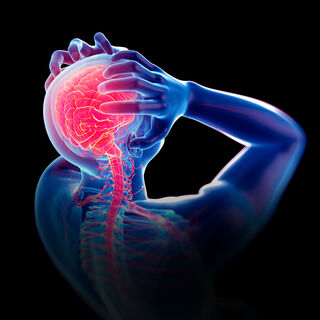Stress
Your Brain and PTSD
Biomarkers and high-stress states
Posted August 27, 2020 Reviewed by Kaja Perina

If you’re reading this, you’re probably stressed. Whether it’s related to work, household chores, parenting, school, politics, or, yes, COVID, stress is a normal part of life.
Because stress is a normal part of life, our bodies have adapted to react to stress through a series of neurophysiological responses. Once the stressor or threat has been resolved, we settle back into a state of repose. This ability to maintain a sense of balance or homeostasis over time and while dealing with change has been described as allostasis. When the body is bombarded by too many stressors, however, the myriad mediators in the body that have been assigned with maintaining balance begin to break down. This is known as allosteric overload, and research has indicated that it can arise when an individual experiences chronic low levels of stress. If uncorrected, allosteric overload can contribute to increased risk of cardiovascular disease, abdominal obesity, and changes in neural circuitry, particularly in the hypothalamus-pituitary-adrenal (HPA) axis and the hippocampus.
The science is clear: Chronic stress, even at low levels, is not merely something that we experience. There are physical correlates to mental stress that include changes in neurochemicals and neural circuitry.
If this is true, then there should also be a means of testing for more serious stress-related disorders like post-traumatic stress disorder (PTSD). After all, the dysregulation of the HPA axis is a crucial property of PTSD and pertains to its core symptomology: hypervigilance, heightened startle response, intrusive and distressing thoughts, etc. Theoretically, there should be some kind of neurological indication that the patient is suffering from PTSD.
Precision Medicine and Mental Health
When a person visits their primary care physician or goes to a modern medical facility, they typically receive a form of personalized care. Personalized medicine takes into account relevant clinical and sociodemographic data about patients before advising treatments.
Precision medicine, meanwhile, has become the term of choice to denote a more technologically advanced and sophisticated means of diagnosing and treating conditions. Precision medicine includes the field of pharmacogenomics, which studies the interplay of pharmaceuticals and genes, and often relies on the use of novel neuropsychological tests, advanced imaging technologies, and biomarkers. “Biomarkers,” have been defined by the National Institute of Health as, “A characteristic that is objectively measured and evaluated as an indicator of normal biological processes, pathogenic processes or pharmacologic responses to a therapeutic intervention.”
Within the field of mental health, biomarkers and precision medicine have an especially important role to play. In most other medical fields, patients describe phenomena (symptoms), and then physicians use this information to guide them as they look for objective phenomena (signs such as inflammation, discoloration, rashes, etc.) that will allow them to arrive at a diagnosis.
Diagnosing mental illnesses, however, depends far more on elements of personalized medicine (knowing a patient’s family history and personal history, for example) and the interpretation of symptoms rather than the search for signs. In many ways, symptoms themselves constitute a diagnosis because many mental illnesses are multidimensional constructs that result from heterogenous etiological processes. A diagnosis of PTSD, for example, is warranted when a patient meets specific symptomatologic criteria following a traumatic event.
This is problematic for several reasons, but a major challenge is that patients are not always reliable when they convey what they are experiencing with respect to symptoms. Some may either exaggerate or downplay the frequency or intensity of their symptoms, while others may explicitly deny or fabricate symptoms. In some extreme cases, patients may be unable to accurately convey their experiences because of mental illness. For example, a schizophrenic patient who lacks insight into their condition would not refer to their paranoid delusions as delusions. To the patient, these delusions are a part of their reality.
Such scenarios can frustrate the process of diagnosing a patient.
PTSD and Biomarkers
Although psychiatry frequently relies on self-reporting from patients or clinical impressions, it is not because conditions only exist in “the mind.” As mentioned above, these subjective states do have neurophysiological correlates. Unfortunately, we lacked the technological sophistication necessary to use biomarkers as a means of diagnosing patients with mental illnesses until relatively recently. In 2018, researchers in Italy found biomarkers for bipolar disorder.
More recently, it appears as though another team of researchers have found genetic biomarkers that correlate with high stress states. In an article published earlier this year in Molecular Psychiatry, the research team wrote that they discovered blood gene expression changes in patients experiencing low- and high-stress states. Candidate genes include FKBP5, DDX6, B2M, LAIR1, RTN4, and NUB1.
While this is undoubtably a major breakthrough, some questions still remain. “Some of these candidate gene expression biomarkers are increased in expression in high stress states (being putative risk genes), and others are decreased in expression (being putative protective/resilience genes),” the authors of the paper wrote. However, the researchers have not been able to discern “which of them are a reflection of damage and which are compensatory mechanisms.”
Still, the research is promising. In addition to giving more validity to stress-related disorders like PTSD, these biomarkers may also eventually help provide insights into non-environmental factors that contribute to patient resilience, predict susceptibility to stress-related disorders, and pave the way for novel and better targeted pharmaceutical treatments for PTSD and perhaps even the more familiar stresses that we experience day-to-day.
This article also published on KevinMD.
.




